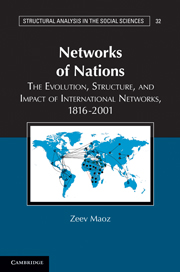Book contents
- Frontmatter
- Contents
- Preface
- Part I What Are International Networks?
- 1 Social Network Analysis and the Study of World Politics
- 2 Fundamental Issues in Social Network Analysis: Concepts, Measures, Methods
- 3 The Network Structure of the International System, 1816–2001
- 4 Security Egonets: Strategic Reference Groups and the Microfoundations of National Security Policy
- Part II The Formation of International Networks: Theory and Evidence
- Part III The Implications of the Networked International Politics Theory
- Glossary
- Bibliography
- Author Index
- Subject Index
4 - Security Egonets: Strategic Reference Groups and the Microfoundations of National Security Policy
Published online by Cambridge University Press: 05 June 2012
- Frontmatter
- Contents
- Preface
- Part I What Are International Networks?
- 1 Social Network Analysis and the Study of World Politics
- 2 Fundamental Issues in Social Network Analysis: Concepts, Measures, Methods
- 3 The Network Structure of the International System, 1816–2001
- 4 Security Egonets: Strategic Reference Groups and the Microfoundations of National Security Policy
- Part II The Formation of International Networks: Theory and Evidence
- Part III The Implications of the Networked International Politics Theory
- Glossary
- Bibliography
- Author Index
- Subject Index
Summary
Introduction
A key assumption of this book is that international structures emerge out of the complex interaction among agents. For the purposes of this study, I consider the principal agents to be nation states. To understand how international networks emerge and how they evolve and change, we must have a theory that deals with the following questions:
What factors drive the calculations and choices of individual states?
How do these factors operate in the process of national policy making?
What kind of national choices result from such processes?
What is the system of interactions (Schelling, 1978: 14; Maoz, 1990b: 33–36) that defines how these national choices aggregate into international processes?
This chapter attempts to answer the first three questions. Chapter 5 focuses on the remaining one.
- Type
- Chapter
- Information
- Networks of NationsThe Evolution, Structure, and Impact of International Networks, 1816–2001, pp. 109 - 144Publisher: Cambridge University PressPrint publication year: 2010

